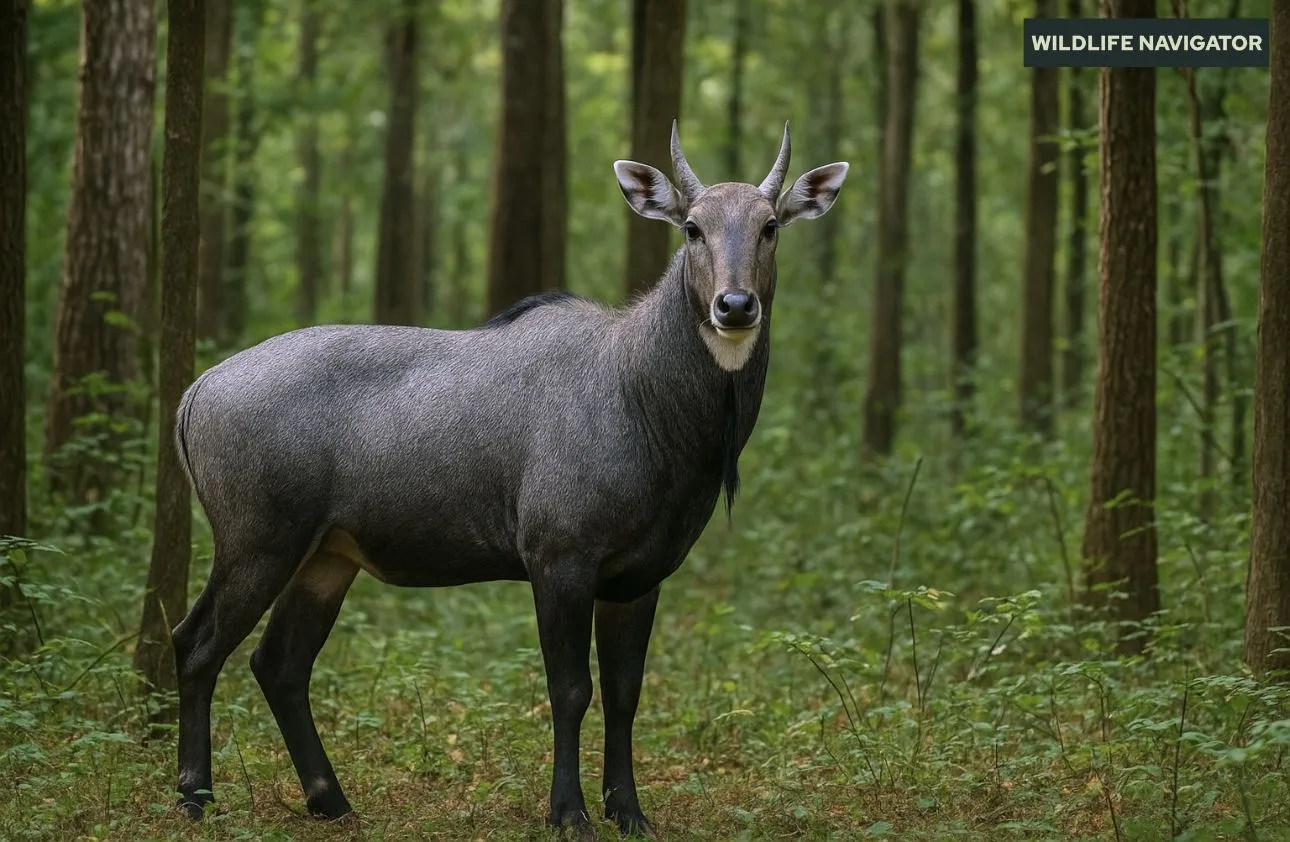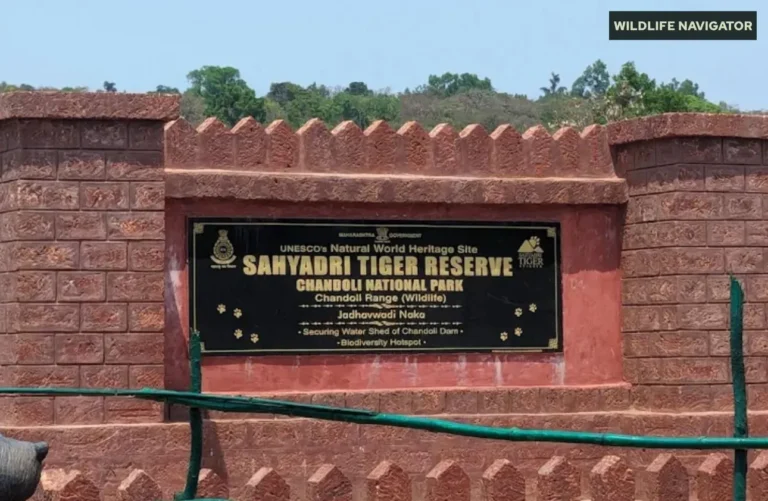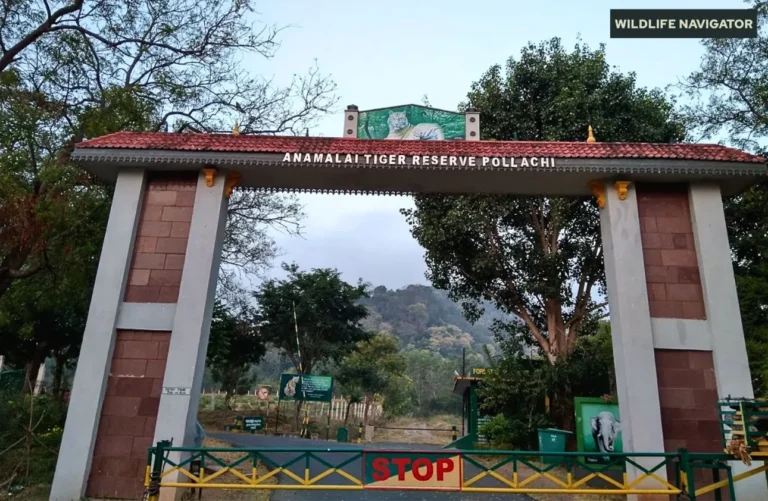Nilgai: The Blue Bull of India’s Grasslands

The Nilgai (Boselaphus tragocamelus), commonly known as the Blue Bull, is one of the most iconic and widespread antelopes of India. Graceful yet sturdy, this majestic animal roams freely across the country’s open plains, dry deciduous forests, and scrublands. As the largest Asian antelope, the Nilgai holds a unique place in India’s wildlife heritage. Its bluish-grey hue in males and tawny shade in females make it easily recognisable in the wild.
Beyond its appearance, the Nilgai plays a crucial ecological role as a grazer, maintaining grassland balance and supporting predator-prey dynamics. Found abundantly across northern, central, and western India, this remarkable species has adapted well to human-dominated landscapes — often seen wandering near farmlands, sometimes sparking both awe and conflict among rural communities.
Physical Characteristics
The Nilgai stands out as a symbol of strength and grace among India’s wild herbivores. Adult males are easily identified by their striking bluish-grey coat, which gives rise to their popular name — Blue Bull. Females, on the other hand, are a warm fawn or orange-brown, creating a clear contrast within the species. Nilgai possess a robust, horse-like build, with long slender legs, a deep chest, and a short neck ending in a narrow, elongated head.
Males are larger than females, standing about 1.2 to 1.5 meters tall at the shoulder and weighing up to 240 kilograms, while females are lighter and shorter. Both sexes feature a white patch on the throat, white facial markings, and a tuft of black hair on the tail tip. Only males develop short, conical horns, typically 15–25 cm long, which are used for display and sparring during dominance fights. Their overall appearance — part cow, part horse, part antelope — makes the Nilgai one of the most visually distinctive animals in India’s grassland ecosystems.
Habitat and Distribution
The Nilgai is one of the most adaptable wild ungulates in India, thriving in a wide range of habitats — from dry deciduous forests and thorn scrublands to open grasslands and agricultural fields. They prefer plains and low hills with sparse tree cover, where visibility is high and food sources are abundant. Unlike forest-dwelling herbivores, Nilgai favour open country, often seen grazing in farmlands or resting under scattered acacia trees.
Their distribution spans a vast stretch of the Indian subcontinent. They are commonly found across northern, central, and western India, especially in Rajasthan, Haryana, Uttar Pradesh, Madhya Pradesh, Gujarat, and Maharashtra. Smaller populations also occur in parts of Punjab, Delhi, Bihar, and Karnataka. Interestingly, Nilgai have even established populations outside India — introduced to Nepal and southern Texas (USA), where they were brought in during the early 20th century and have since adapted remarkably well.
Nilgai are commonly found:
Northern India
- Ranthambore National Park (Rajasthan) – open scrub and grassland areas.
- Sariska Tiger Reserve (Rajasthan) – frequent sightings in dry forests and farmland edges.
- Kuno-Palpur Tiger Reserve (Madhya Pradesh) – grasslands and open scrub zones.
Central India
- Panna Tiger Reserve (Madhya Pradesh) – often seen grazing near rivers and open meadows.
- Bandhavgarh National Park (Madhya Pradesh) – Nilgai found in peripheral grasslands.
- Kanha National Park (Madhya Pradesh) – occasional sightings in forest clearings.
Western India
- Pench Tiger Reserve (Madhya Pradesh / Maharashtra) – seen in scrub forests and farmland areas near the reserve.
- Tadoba-Andhari Tiger Reserve (Maharashtra) – Nilgai are common in open patches and near villages.
Nilgai’s success lies in their ability to live close to human settlements. They graze alongside livestock, raid crops, and adapt to fragmented habitats — a survival skill that has allowed them to flourish even as natural grasslands shrink across India.
Behaviour and Social Structure
Nilgai are known for their alertness, calm demeanour, and strong sense of territory. They are primarily diurnal, meaning they are active during the early morning and late afternoon hours when the temperatures are cooler. Most of their day is spent grazing, resting under shade, or standing motionless in open fields — their stillness often helping them blend into the dry landscape.
Socially, Nilgai live in small herds, usually composed of females and their young, while adult males are mostly solitary or found in bachelor groups. Herds are generally loose and fluid, coming together mainly during the breeding season. The social hierarchy is maintained through displays of dominance — males often engage in neck-pressing and horn-clashing bouts, though serious fights are rare.
When threatened, Nilgai rely on their exceptional speed and endurance, capable of running up to 50 km/h. They are also strong jumpers, easily clearing high fences and obstacles — a reason they often venture into cultivated fields. Despite their size, they are surprisingly silent animals, communicating through subtle body gestures, snorts, or alarm calls when sensing danger.
In areas close to villages, Nilgai have developed a cautious relationship with humans. Farmers often view them as crop raiders, while local communities, due to their resemblance to the sacred cow, are reluctant to harm them — creating a unique dynamic of both conflict and coexistence.
Diet and Feeding Habits
The Nilgai is a strict herbivore, perfectly adapted to India’s semi-arid and open landscapes. Its diet mainly consists of a wide variety of grasses, leaves, crops, and fruits, depending on seasonal availability. As an adaptable grazer and browser, the Nilgai adjusts its feeding habits to what nature offers — a key reason for its survival across such diverse habitats.
Primary Diet Components:
- Grasses: Tender shoots and dry grasses form a large part of their diet, especially during the monsoon and post-monsoon seasons.
- Leaves and Shrubs: They browse on acacia, ber, and other hardy plants in scrub forests.
- Fruits and Pods: Nilgai occasionally feed on fallen fruits and seed pods, especially from trees like Prosopis juliflora and Acacia.
- Crops: In agricultural areas, they often raid fields of wheat, mustard, pulses, and sorghum, causing frequent conflict with farmers.
Nilgai possess a remarkable ability to digest fibrous vegetation and can survive for long periods without direct access to water, drawing moisture from the plants they consume. Their selective grazing helps maintain the grassland ecosystem by preventing overgrowth and promoting plant diversity.
However, this very adaptability sometimes makes them a nuisance in farmlands, as large herds can damage standing crops overnight. Balancing their natural grazing habits with agricultural interests remains one of the key challenges in managing human–Nilgai interactions.
Reproduction and Life Cycle
The Nilgai follows a well-defined and seasonal reproductive cycle that reflects the rhythm of India’s grassland ecosystems. Breeding usually occurs between December and March, though timing may vary slightly depending on regional climates and food availability. During this period, males become more territorial and display heightened aggression, marking their dominance through scent marking, horn clashes, and ritualised postures.
Key Stages of Nilgai Reproduction:
- Mating Season: Peaks in winter when males compete for receptive females through visual displays and brief confrontations.
- Gestation Period: Lasts around 8 to 9 months, with most births occurring just before the monsoon season — ensuring abundant vegetation for nursing mothers.
- Calving: Females usually give birth to one or two calves, which are hidden in tall grasses for the first few weeks to protect them from predators.
- Parental Care: Mothers are highly protective, visiting their calves several times a day for nursing while keeping them concealed.
- Growth: Young Nilgai join the herd after about a month and gradually gain independence, reaching maturity at around 2 to 3 years of age.
Nilgai can live up to 20 years in the wild, though predation and habitat pressures often shorten their lifespan. Their reproductive success and ability to breed regularly contribute to their stable population across India — a rare trait among large herbivores facing shrinking habitats.
Ecological Role
Nilgai play a vital role in maintaining the balance of India’s grassland and scrub ecosystems. As primary grazers and browsers, they help regulate vegetation growth, preventing overdominance of certain plant species. Their grazing activity promotes fresh regrowth, benefiting other herbivores and supporting biodiversity.
They also serve as prey for large carnivores such as tigers, leopards, and wolves, thus contributing to the food chain. By dispersing seeds through their dung, Nilgai aid in natural regeneration of plants across open landscapes. In essence, their presence helps sustain the delicate harmony of India’s dry ecosystems.
Threats and Conservation Status
Although the Nilgai is listed as “Least Concern” on the IUCN Red List, the species faces several local challenges that threaten its long-term survival. Its wide distribution often hides the pressures it endures in many parts of India.
Major Threats:
- Habitat Loss: Rapid conversion of grasslands and scrub forests into agricultural land and urban areas has reduced their natural range.
- Human–Wildlife Conflict: Crop depredation by Nilgai frequently leads to tension with farmers, resulting in retaliatory measures or calls for population control.
- Road Accidents: Nilgai are often victims of vehicle collisions, especially in areas where highways cut through their habitats.
- Illegal Hunting: Though culturally protected in many regions, poaching for meat still occurs in some remote areas.
Despite these threats, Nilgai populations remain relatively stable due to their adaptability and tolerance to human presence. Conservation efforts focus on habitat management, conflict mitigation, and awareness programs that promote coexistence. Protecting India’s remaining grasslands will not only benefit Nilgai but also countless other species that depend on these overlooked ecosystems.
Interesting Facts
The Nilgai is full of surprises, making it one of India’s most fascinating antelopes. Here are some fun and intriguing facts about this species:
- Name Meaning: “Nilgai” literally translates to “Blue Cow” in Hindi, inspired by the bluish-grey colour of adult males.
- Speedy Runners: Despite their bulky frame, Nilgai can sprint up to 50 km/h, helping them escape predators effortlessly.
- Jumping Ability: They are excellent jumpers, capable of leaping over fences and obstacles up to 2 meters high.
- Sacred Status: Many rural communities treat Nilgai as sacred due to their resemblance to cows and rarely harm them.
- Water Independence: Nilgai can survive long periods without drinking water directly, obtaining moisture from leaves and fruits.
- Social Flexibility: They can switch between solitary and herd living, depending on food availability and breeding season.
These traits highlight the Nilgai’s adaptability, resilience, and unique place in India’s wildlife, making it both a common sight and a species worth admiring.
Nilgai and Humans
The Nilgai occupies a unique space in the relationship between wildlife and human communities in India. Its cow-like appearance has earned it cultural respect in many villages, where harming it is considered taboo. This reverence has contributed to the species’ widespread survival across farmlands and semi-urban areas.
Human Interactions:
- Crop Raiding: Nilgai often feed on wheat, mustard, pulses, and sorghum, causing economic losses for farmers.
- Conflict Management: Forest departments use fencing, scarecrows, and community awareness programs to reduce crop damage.
- Cultural Significance: In folklore and rural traditions, Nilgai are sometimes associated with prosperity and protection, reflecting the spiritual connection villagers have with wildlife.
- Coexistence Strategies: Many communities encourage non-lethal deterrents and relocate problem herds rather than resorting to hunting.
This relationship showcases the delicate balance between respecting wildlife and protecting livelihoods. With proper management and awareness, humans and Nilgai can continue to coexist harmoniously in India’s shared landscapes.
Photography and Observation Tips
Observing and photographing Nilgai can be a rewarding experience, especially for wildlife enthusiasts and photographers. Their alert yet calm nature allows for close observation if approached carefully.
Best Practices for Spotting Nilgai:
- Timing: Early morning and late afternoon are ideal for sightings, as Nilgai are most active during cooler hours.
- Locations: Some of the best places in India include:
- Bharatpur and Keoladeo National Park (Rajasthan)
- Ranthambore (Rajasthan)
- Velavadar Blackbuck National Park (Gujarat)
- Madhya Pradesh grasslands and semi-arid forests
- Approach: Move slowly and quietly; sudden movements can startle them.
- Equipment: Use a telephoto lens (200mm or higher) for close-up shots without disturbing them.
- Ethical Photography: Avoid chasing or feeding Nilgai; respect their space and natural behaviour.
By following these tips, you can capture stunning images while observing Nilgai in their natural habitat, gaining a deeper appreciation for India’s grassland wildlife.
Conclusion
The Nilgai, India’s largest antelope, is much more than just a striking presence on the plains. Its adaptability, ecological role, and cultural significance make it a vital part of India’s grassland and scrub ecosystems. From grazing and seed dispersal to serving as prey for apex predators, Nilgai contribute to the health and balance of their habitats.
At the same time, their interactions with humans — both reverent and conflict-prone — highlight the challenges of coexistence in shared landscapes. By promoting awareness, implementing non-lethal management strategies, and protecting remaining grasslands, we can ensure that Nilgai continue to thrive alongside people. Observing these elegant animals in the wild offers not only a glimpse into India’s biodiversity but also a reminder of the delicate harmony between humans and nature.





